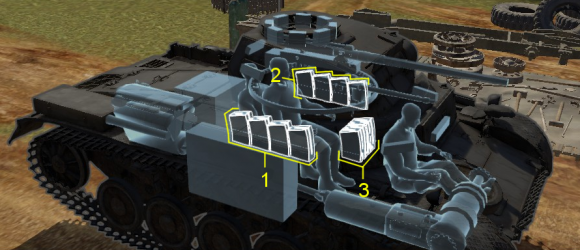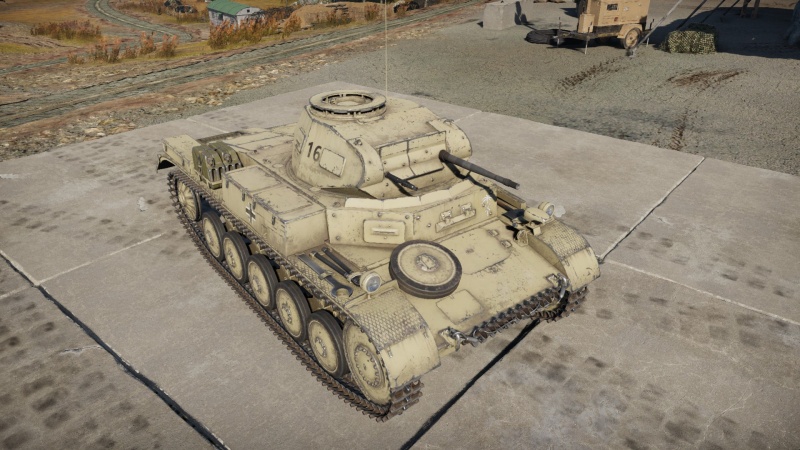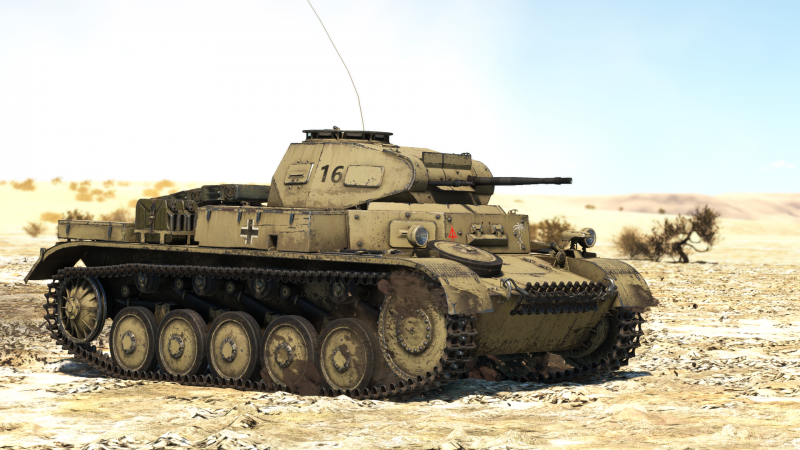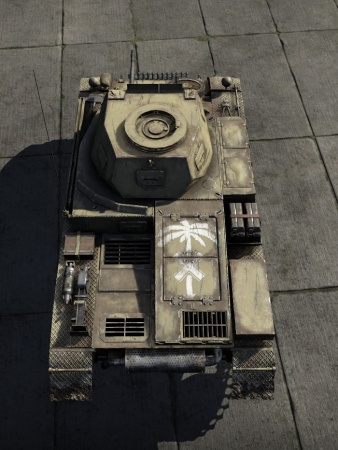Pz.II C (DAK)
| This page is about the German light tank Pz.II C (DAK). For other versions, see Pz.II (Disambiguation). |
Contents
Description
The Pz.II C DAK (Deutsches Afrikakorps) was a variant of the Pz.II C used by the Afrika Korps, a German expeditionary force in Africa during the North Africa campaign. Initially sent as a defensive force to help Italy defend its African colonies, the formation fought in Africa under several names from March 1941 until its surrender in May 1943. The Panzer II C (DAK) primarily operated in the desert with the 2nd Battalion, 5th Panzer Regiment, 21st Division. The cooling air intake and exhaust apertures were expanded in these tanks, and the radiator fan was replaced with a high-performance version to cope with the intense desert temperatures.
Introduced in the Closed Beta Test for Ground Forces before Update 1.41, the premium Pz.II C (DAK) is a unique historical vehicle that is identical in performance to the standard Pz.II C variant. It is painted in desert camouflage to reflect its involvement in the North African campaign. Despite the modifications made to the Pz.II C (DAK) during service, they are not actively portrayed in the game. In general, the Pz.II C (DAK) is a dangerous light tank in the hands of an experienced player. As most enemy tanks in the early ranks are rather weakly armoured, the Pz.II C (DAK) can unleash a barrage of armour-piercing shells with the Kampfwagenkanone (KwK) 30 L/55 20 mm autocannon, crippling most opponent tanks with a single ammunition clip. The Pz.II C (DAK) could be acquired for free during the 2017 "German Unity Day" event.
General info
Survivability and armour
The Pz.II C has (on the surface) decent frontal armour, with 35 mm for the front plate with a section of heavily sloped 30 mm armour on the glacis, then a sloped lower glacis that has 35 mm as well. The side, rear, and hull roof armour are a paltry 15 mm, including the turret sides. The front turret face is 30 mm that do not overlap with the 30 mm thick gun mantlet well so it will be rare, if not impossible, for a chance at relying on a 60 mm overlapping area to deflect rounds.
Generally speaking, the Pz.II C does not have enough armour to defend itself unless fighting from an extreme range (which most early-ranked tanks can't reasonably do well), facing SPAA vehicles that are only using high-explosive shells or facing against some early-ranked French tanks.
Put shortly - do everything to ensure that the Pz.II C does not get hit, because even one well placed shot in the crew compartment will likely knock the Pz.II C out.
Armour type:
- Rolled homogeneous armour
| Armour | Front (Slope angle) | Sides | Rear | Roof |
|---|---|---|---|---|
| Hull | 20 + 14.5 mm (6°) Upper plate 14.5 mm (74°) Upper glacis 20 mm (33°) Lower glacis |
14.5 mm | 14.5 mm (6°) Upper plates 10 mm (61°) Lower glacis |
14.5 mm (16°) Front glacis 15 mm Crew compartment 14.5 mm Rear 10 mm (9°) Engine access panel 5 mm Vents |
| Turret | 20 + 14.5 mm (cylindrical) Turret front 14.5 + 14.5 mm (cylindrical) Gun mantlet |
14.5 mm (21°) | 15 mm (24°) | 10 mm (15°) Front 10 mm Rear |
| Cupola | 15 mm (cylindrical) | 10 mm | ||
Notes:
- Suspension wheels and torsion bars are 10 mm thick while tracks are 15 mm thick.
- Mudguards are 4 mm thick.
- Belly armour is 5 mm thick.
Mobility
| Game Mode | Max Speed (km/h) | Weight (tons) | Engine power (horsepower) | Power-to-weight ratio (hp/ton) | |||
|---|---|---|---|---|---|---|---|
| Forward | Reverse | Stock | Upgraded | Stock | Upgraded | ||
| Arcade | Expression error: Unexpected * operator. | 217 | Expression error: Unexpected round operator. | __.__ | |||
| Realistic | 124 | Expression error: Unexpected round operator. | __.__ | ||||
Mobility-wise, the Pz.II C is actually better than most of its peers, but the BT series tanks and M3 Stuarts will still outpace it quite easily. Regardless, the Pz.II C can get around the battlefield quite respectably, and the vehicle's power-to-weight ratio makes it easy to go up steep inclines than larger, heavier vehicles. However, the Pz.II C is not going to outrun a pursuing enemy team, so locating good cover is immensely useful for its survival.
Modifications and economy
Armaments
Main armament
The main armament of the Pz.II C is the 20 mm KwK30 automatic cannon. With the ability to access HVAP capable of penetrating 48 mm at point blank range, combined with its magazine-loaded rapid fire, the 20 mm can puncture through most enemy armour at this battle rating range like it is fabric.
The biggest problem with the 20 mm autocannon is the 10 round magazines combined with a 7.8 s stock reload time, meaning that the tank may successfully take out two or three enemy tanks with controlled bursts, but is likely to be taken out during the reload. Another problem to consider is in the powerful HVAP ammunition, in that its impressive penetration statistics can make the gun reach out to about 200-300 m, but the penetrative power drops off rapidly after that due to velocity drop, even more so than the standard PzGr round.
| 20 mm KwK30 | Turret rotation speed (°/s) | Reloading rate (seconds) | ||||||||||||
|---|---|---|---|---|---|---|---|---|---|---|---|---|---|---|
| Mode | Capacity (Belt) | Fire rate | Vertical | Horizontal | Stabilizer | Stock | Upgraded | Full | Expert | Aced | Stock | Full | Expert | Aced |
| Arcade | 180 (10) | 280 | -9°/+20° | ±180° | Vertical | 13.33 | 18.45 | 22.40 | 24.77 | 26.35 | 7.80 | 6.90 | 6.36 | 6.00 |
| Realistic | 8.33 | 9.80 | 11.90 | 13.16 | 14.00 | |||||||||
Ammunition
- Default: API-T · HEFI-T* - The belt composition means that 50% of the shells (HEFI-T*) are useless against tanks. However, this belt is reliable against open-topped or thin-skinned vehicles like SPAA vehicles. Since there are no dedicated high-explosive shells for the selection, having one belt of this in reserve does not hurt for those situations.
- PzGr: API-T - This belt offers a good transition from the Default to the PzGr 40 belt. The round offers decent damage against lightly armoured tanks, especially at close range. Due to lack of high-explosive filler, however, it is better to focus on the PzGr 40 belt to maximize penetration power.
- PzGr 40: HVAP-T - Probably the best belt with the best penetrating shell for the vehicle. While the damage effects post-penetration can be quite poor, the rapid fire from the autocannon can mitigate this problem by following up quickly with another penetrating shot. In close combat, these shells should be used against modules and crew member to make the most of each shell. Against angled armour, however, the HVAP ammo may not be very effective. Unlike the Flakpanzer 1 and Flakpanzer 38, this belt is still 100% HVAP.
| Penetration statistics | |||||||
|---|---|---|---|---|---|---|---|
| Ammunition | Penetration @ 0° Angle of Attack (mm) | ||||||
| 10 m | 100 m | 500 m | 1,000 m | 1,500 m | 2,000 m | ||
| HEFI-T* | 5 | 4 | 3 | 2 | 2 | 2 | |
| API-T | 37 | 34 | 23 | 14 | 9 | 6 | |
| HVAP-T | 48 | 45 | 31 | 20 | 13 | 8 | |
| Shell details | ||||||||||||
|---|---|---|---|---|---|---|---|---|---|---|---|---|
| Ammunition | Velocity (m/s) |
Projectile mass (kg) |
Fuse delay (m) |
Fuse sensitivity (mm) |
Explosive mass (TNT equivalent) (g) |
Ricochet | ||||||
| 0% | 50% | 100% | ||||||||||
| HEFI-T* | 900 | 0.12 | 0.1 | 0.1 | 10.2 | 79° | 80° | 81° | ||||
| API-T | 800 | 0.15 | - | - | - | 47° | 60° | 65° | ||||
| HVAP-T | 1,050 | 0.1 | - | - | - | 66° | 70° | 72° | ||||
Ammo racks

| Full ammo |
1st rack empty |
2nd rack empty |
3rd rack empty |
Visual discrepancy |
|---|---|---|---|---|
| 18 | 11 (+7) | 7 (+11) | 1 (+17) | No |
Notes:
- Ammunition is modeled as 18 magazines of 10 rounds.
- Racks disappear after you've fired all magazines in the rack.
- Right flank empty: 11 (+7) magazines.
Machine guns
Mounted opposite to the 20 mm autocannon is the MG 34, which is loaded with a 50-round belt with an AP-I/AP-I/AP-T ammo pattern. With 13 mm of maximum penetration at point blank range, this MG's high rate of fire will make short work of unarmoured vehicles like truck-based SPAA, as well as exposed enemy crewmen.
| 7.92 mm MG34 | ||||
|---|---|---|---|---|
| Mount | Capacity (Belt) | Fire rate | Vertical | Horizontal |
| Coaxial | 1,800 (150) | 900 | N/A | N/A |
Usage in battles
The main key to success with this vehicle is to drive aggressively, trying to get shots at relatively close range (100-300 m or even less). Aiming for the enemy's weak spots, it is often possible to set your opponent on fire, allowing the Pz.II to take on vehicles beyond its battle rating.
Where possible, try to use the terrain to remain hull down. Even the smallest undulations are quite often enough to mask your hull, allowing you to take quick shots with minimal risk. However closing the distance quickly with your opponent is really the only way to reliably destroy the enemy, as your armour is not enough to bounce a shot in a close-quarters fight.
Alternatively, the Pz.II C can be played as a support vehicle, a second line tank, to say the least, to assist more armoured allies when pushing the cap. Use short bursts (2-4 rounds ideally) to disable enemy vehicles by targeting weak points like their transmission or turret crew, then use the remaining ammo to take out the rest of the enemy crew, or let friendly tankers take them out for assists. The Pz.II C lacks the mobility to disengage and run from tanks like the M3 Stuarts or BT series tanks, but if their transmission, driver, or tracks are taken out, they will be temporarily immobilized and the Pz.II C player has bought themselves time to scurry back to friendly lines, where more powerful guns and numbers can be brought to counter the enemy.
Also, as a light tank with decent speed and low profile, the Pz.II C can act as a spotter (unfortunately without the use of the scout mechanics) to locate enemy tanks for allies to prioritize and hit with guns, artillery, or airstrikes.
The biggest threat to the Pz.II C on the battlefield are tanks that have very good armour and firepower at the expense of their mobility. The Valentine, FCM.36, and Matilda are examples of tanks that will easily deflect even 20 mm PzGr 40 shots, either due to their impressive frontal hull and turret armour, or just because they are so slow that the Pz.II C will engage them at ranges that render the shell penetration power ineffective. If one of these tanks are spotted trundling along in the distance, do not bother taking the shot because the 20 mm are unlikely able to do even cosmetic damages, while at the same time drawing their attention and revealing the Pz.II C's position due to the shell tracers.
Generally speaking, if the target is about the size of a coin when looking at it on max zoom in the gunner's sight, it is too far for effective fire and should not be engaged.
A more advanced method of playing this is to use it like an autoloading gun from higher BRs - fire only one or two shots per click at a given time. This helps avoid spraying uselessly at bigger, more stubborn targets.
Pros and cons
Pros:
- Decent frontal armour: when angled it can be immune to common opponents like the BT-5, BT-7, M3A1 and A13
- Overall superior firepower: autocannon shoots rapidly, resulting in denser fire, and with the PzGr 40 belt it can penetrate any tank, including the B1 bis when aiming correctly
- Fast top speed and good agility makes it a great flanker, it can easily out-manoeuvre slower tanks like T-26 or H.35
- Curved turret armour of 30 mm plus -10 degrees gun depression allows it to hull-down on hills easily
- Small width means it can manoeuvre through or hide in narrow passages in urban maps, allowing it to ambush or flank unexpectedly
- Low profile makes it easy to hide behind bushes or cover
- In Simulator mode, friendly fire is less likely due to the very distinct shape and profile
- Shoulder stabilizer allows the Panzer to shoot while moving
Cons:
- Only performs well at close quarters combat, as both the AP and HVAP penetration drop below 30 mm past 500 m, making it struggle to penetrate common opponents such as the M3/M5 Stuart and B1 bis
- Magazine-loaded armament means there is lengthy downtime for reloading where you are vulnerable
- Survivability is still inadequate: unsloped armour plus closely-packed crew of 3 means it is very vulnerable to T-26, BT-5 or M8 Scott which all have explosive AP
- Although top speed is good, it is still slower than other light tanks like the infamous BT-5, M8 Greyhound and M3/M5
History
Development
In 1934, the development of the new German tanks, which would be the Panzer III and Panzer IV, was falling behind schedule despite an urgent need for tanks. As a stopgap solution until the designs was finalized, the Germany Army submitted a request for a new tank, giving the responsibility of designing to Krupp, MAN, Henschel, and Daimler-Benz.
The product was a design that is based off the German Panzer I light tank, but was larger with the addition of an extra bogie wheel and had a 20 mm autocannon as its main armament. The finished tank was designated the Panzer II and production was to start in 1935 but did not start delivering tanks until 18 months later. At this time, it was in a low rate production status by 1936 in the Panzer II Ausf. C variant. In the 1940s, the Panzer II was upgraded to the Panzer II Ausf. F, which entered into production in 1941 with increased armour and a torsion bar suspension system. A total of 524 Ausf. F were produced between March 1941 to December 1942.
The Panzer II Ausf. F had a 35 mm front armour and 20 mm side armour compared to the 14 mm all-around armour on the Ausf. C. The 20 mm autocannon on the turret was the same, based off the 20 mm FlaK 30 then in use with a rate of fire of 600 rpm from a 10-round magazine. The tank also came with a coaxial machine gun as well. The turret was hand cranked by the commander, who doubled as the gunner of the tanks. The crew of the Panzer II consist of three people, the driver, commander, and loader who doubled as a radio operator. The Panzer II Ausf. C could reach a speed of 53 km/h (33 mph) with its torsion-bar suspension
Combat usage
The Panzer II would serve in the initial stages of World War II in the Battle of Poland, France, and Operation Barbarossa as Germany's most numerous tank (By May 1940, there were about a thousand Panzer Is and IIs, but only 381 Panzer III and 290 Panzer IVs). The Panzer II also saw service in the German Afrika Korps (Deutsches Afrikakorps, "DAK") during the Northern Africa campaign. By 1941, it was clear that the Panzer II was starting to become obsolete, and with the increasing quantity of Panzer IIIs and IVs, the Panzer II was relegated to reconnaissance duties when going against the Allies.
Despite the up-armouring in the different Panzer II variants, the Panzer II could still be penetrated by the most towed anti-tank weapon in service at the time, leaving the crew at risk to enemy fire. By 1942, it was largely removed from front lines and production ceased by 1943. The turrets of these obsolete tanks were used as gun turrets on defensive bunkers on the Atlantic Wall, and the chassis stayed in use for other purposes, such as a self-propelled gun and tank destroyer in the Wespe and Marder II respectively.
| Archive of the in-game description | |
|---|---|
|
Some of the Pz.Kpfw IIs were sent to Africa, where they were used by the German Afrika Korps (DAK). In Africa they were given secondary tasks such as guard duty and scouting. The tank is shown with desert camouflage and the famous symbol of the African Corps, the palm tree. | |
Media
- Skins
- Sights
- Images
See also
- Related development
- Other vehicles of similar configuration and role
External links
| Germany light tanks | |
|---|---|
| Pz.II | Pz.II C · Pz.II C (DAK) · Pz.II C TD · Pz.II F · Pz.Sfl.Ic |
| Sd.Kfz.234 | Sd.Kfz.234/1 · Sd.Kfz.234/2 · Sd.Kfz.234/2 TD |
| Marder | Marder A1- · Marder 1A3 · Begleitpanzer 57 · DF105 |
| SPz PUMA | PUMA · PUMA VJTF |
| Wheeled | Sd.Kfz.221 (s.Pz.B.41) · Class 3 (P) · Radkampfwagen 90 · Boxer MGS |
| Other | Ru 251 · SPz 12-3 LGS |
| Argentina | TAM · TAM 2C · TAM 2IP · JaPz.K A2 |
| Czechoslovakia | Pz.35(t) · Pz.38(t) A · Pz.38(t) F · Pz.38(t) n.A. · Sd.Kfz. 140/1 |
| France | Pz.Sp.Wg.P204(f) KwK |
| Lithuania | Vilkas |
| USA | leKPz M41 |
| USSR | SPz BMP-1 |
| Germany premium ground vehicles | |
|---|---|
| Light tanks | Pz.II C (DAK) · Pz.Sfl.Ic · Pz.Sp.Wg.P204(f) KwK · Sd.Kfz. 140/1 · Sd.Kfz.234/1 · Ru 251 · SPz 12-3 LGS · TAM 2IP |
| Medium tanks | Nb.Fz. · Pz.III N · Pz.Bef.Wg.IV J · ▀M4 748 (a) · ▀T 34 747 (r) · Ersatz M10 |
| mKPz M47 G · Turm III · Leopard A1A1 (L/44) · Leopard 2 (PzBtl 123) · Leopard 2A4M | |
| Heavy tanks | ▀Pz.Kpfw. Churchill · ▀KV-IB · ▀KW I C 756 (r) · ▀KW II 754 (r) |
| VK 45.01 (P) · ␠Tiger · Pz.Bef.Wg.VI P · Tiger II (H) Sla.16 | |
| Tank destroyers | Sd.Kfz.234/3 · Sd.Kfz.234/4 · Sd.Kfz.251/10 · Sd.Kfz.251/22 · 15 cm Pz.W.42 |
| Brummbär · Panzer IV/70(A) · VFW · Bfw. Jagdpanther G1 · Elefant · 38 cm Sturmmörser | |







